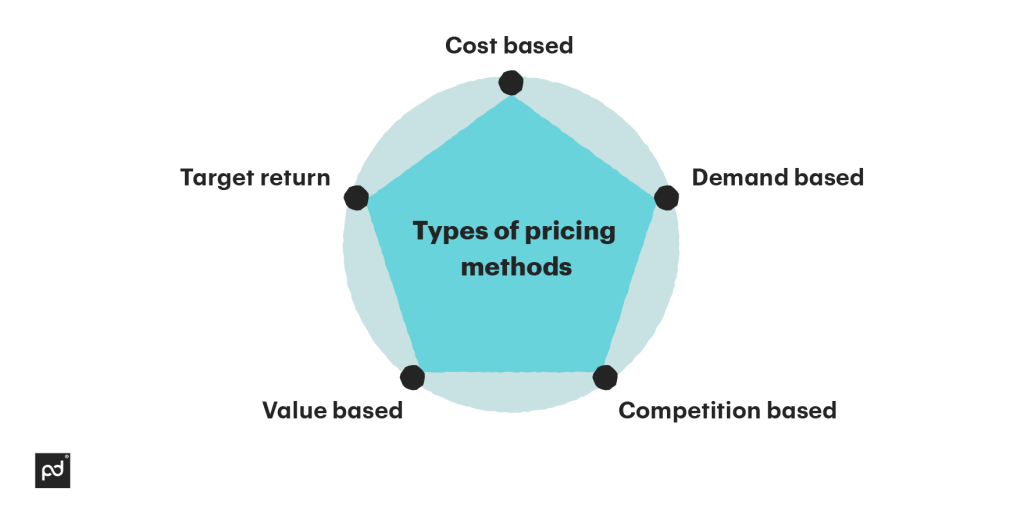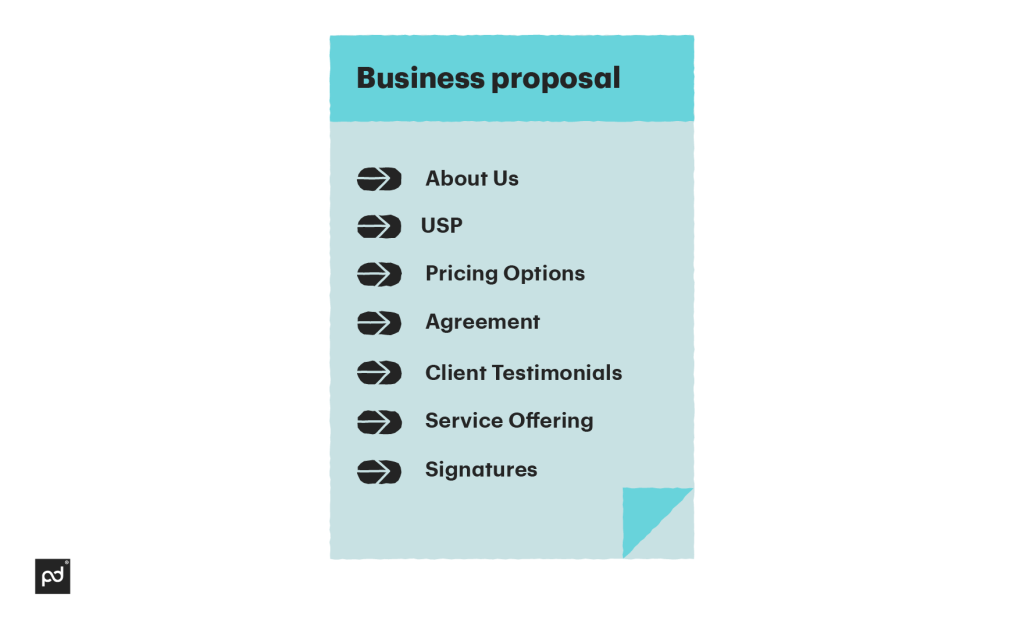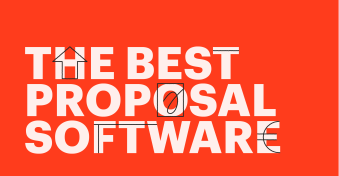Be it sales items, groceries, or software solutions — we all love to price shop.
Your potential clients are no different. To confirm if they’re getting the best deal (or not), they’ll ask multiple vendors to provide a quote for the same solution.
This “quote” usually comes in the form of a pricing proposal. What is a pricing proposal exactly, you might ask?
Well, if that’s the case, you’ve landed on the right page. Read on to discover the whats, whys, and hows of proposal pricing.
What is proposal pricing?
Proposal pricing, also known as price proposal or pricing proposal, is a document created when potential clients send an RFP (request for proposal) or an RFQ (request for quote).
The purpose of a pricing proposal is to help potential clients understand how much a project may cost (and what are all the items included in that price).
A contractor may create this document with a certain pricing methodology in mind, such as daily or hourly rate, monthly, cost-based, time and materials-based, etc.
A pricing proposal serves as the document that has the absolute final price — it’s not an estimate, and it generally can’t be negotiated later on. It also includes an itemized summary of all deliverables.
→DOWNLOAD NOW: FREE PRICING PROPOSAL TEMPLATE
How do you price a proposal?
1. Add bundled packages
You could pitch an individual service on your price proposal — but since it’s the perfect opportunity to upsell, why hold back? In your proposal, show your services in a bundle.
For example, if you’re a writer, instead of just agreeing to write an ebook, you can bundle your service as an ebook + content upgrade + two blogs + keyword research.
This allows you to work on a bigger project, and it also allows your clients to get better results through a well-rounded strategy (and who knows — maybe the bundled services might cost them less than if individually purchased. A win-win!)
2. Price based on the value you provide
The value-based pricing model is an effective pricing strategy for two reasons:
- It allows you to scale (hence it’s a long-term fit).
- Your price is based on the results your product/service delivers; hence it’s another win-win for both parties.
Although finding out the value of your product/service may be a difficult guess, what you can do is reverse calculate the price.
Keeping up with the analogy of a writer, if the emails you write result in 2x revenue for your clients, you can base your prices accordingly.
3. Provide pricing options
Think about it: any place you go to, you’re not stuck with only one option that you have to say yes or no to.
For example, hotels don’t have rooms in only one size, a travel agency will never suggest just one type of travel plan, and even so much so as buying a plane ticket has different kinds of seating options.
Some customers prefer to be budget conscious, whereas others may need to meet specific deliverables, which might lead them to shell out an extra buck or two.
Providing options in pricing (and deliverables) allows customers to choose whichever option suits them best, thereby increasing the probability of clients agreeing to your services.
However, the trick is not only to showcase pricing options but to also onboard clients faster by creating efficient processes.
Besides having greater visibility of your pipeline, an efficient onboarding process makes sales enablement a whole lot easier — you’re ensuring both parties have all the necessary data at their fingertips.
4. Show the benefit you offer
Pricing proposals are not only there for you to send your price in response to an RFP; rather, you can also use them to explain what value your product provides.
Elaborate on your experience, the deliverables you offer, what value the customers would be getting out of those deliverables, your USP, etc.
Doing so allows your customers to visualize what your product/service can do for them.
And since customers want to buy into the results they can receive, doing so might just increase your chances of getting a yes from a potential client.
Types of pricing methods

1. Cost based
The cost-based pricing method follows the calculation wherein the sellers calculate the unit price of a product, bearing in mind both direct costs and indirect costs such as production, labor, raw materials, marketing, storage, distribution, etc., and then add a markup accordingly.
This markup can be calculated using multiple pricing strategies such as cost plus (percentage-based pricing), target profit (profit-based pricing), break-even (using the price it took to create and distribute the product), and markup (keeping a particular price point in mind).
Most small businesses and freelancers use the cost-plus pricing strategy to decide the right price for the products/services they offer.
Learn more about cost-based pricing and how to calculate it with this guide: Definitive Guide to Cost-Based Pricing with Examples.
2. Demand based
The airline and transportation industries are the ring bearers of demand-based pricing. What they do is hike up prices during a time of demand.
For example, if June is a popular month to fly, tickets would generally be priced higher that time of the year.
In a similar context, theme parks like Disney World increase their prices during a time of high demand. You might also see air conditioners being more expensive during the summer season.
The demand-based pricing model follows the logic of hiking up prices when the demand is high to gain maximum profit.
3. Competition based
The competition-based pricing methodology considers competitor pricing before a business sets prices of its own.
For example, companies that operate in a network, the food delivery niche, or companies from the SaaS industry, most commonly use this pricing model to not alienate their customers solely based on pricing.
Although the competition-based pricing model has multiple benefits, it has its own set of disadvantages too — such as overtly copying your competitors may cause you to lose your unique edge.
The going rate pricing method also follows the same direction, but with the going rate pricing strategy, the prices that are set by industry leaders have to be followed.
Explore more about competition-based pricing and its pros and cons here.
4. Value-based
The value-based pricing model is perhaps the most effective pricing strategy, mainly because it considers the unique value your product/service can provide, and bases prices accordingly.
For example, if two companies operate in the same niche and are competitors, Company A may have three features.
In contrast, Company B may provide six features, so pricing both services similarly doesn’t make sense — in such cases, it makes more sense to price the services of Company B at a higher price point.
Here’s a detailed guide that explains why value-based pricing might be the best pricing strategy for your business.
5. Target return
This pricing model calculates pricing based on the profits a company expects from the products/services they sell.
For example, if a company wishes for a 20% return on investment, then that’s how they’ll make the calculations to come to the right price.
You’ll mainly see the eCommerce industry using this pricing strategy. So here’s how to calculate prices based on target return: TRP = UC + (DR*C)/US
TRP stands for target return pricing, UC for unit cost, DR for desired return, C for the investment, and the US stands for unit sales.
Equity pricing, performance-based pricing, etc., are some of the other types of pricing models.
A few tips on how to construct your pricing proposal
1. Research is your best friend
Not to point out the obvious, but knowing about your potential client, their industry, and the reason why they are looking for a solution, and then constructing a personalized proposal based on those factors immediately increases your chances of getting a yes.
Even if you don’t receive a positive reply, it shows that you took an effort to understand the company and allows potential clients to see you as a worthy candidate.
2. Share a comprehensive proposal
As we mentioned earlier, sharing just the pricing alone in response to an RFP won’t make your price proposal stand out as special in any way.
If you really want to have a cut above the rest, write a comprehensive proposal by showing your USP, client testimonials, services you offer, pricing options, etc.

Here’s how to present a pricing proposal
1. Begin with the budget
To set the budget right, start by identifying all your direct costs (such as labor and raw materials) and indirect costs (such as office rent and insurance).
Once you factor in all the potential costs, add your profit margin to it to come to a final figure (total cost of the project).
2. Present a cover letter
Pricing proposals go beyond just presenting the price — they are also a way of communicating with your potential client (possibility for the first time), and therefore your focus should be on building client confidence.
You can do this by presenting a cover letter, and follow by showing your experience and the benefits of partnering with you in a positive and friendly tone.
3. Add a completion date
Your pricing proposal should also have a completion date. This date may need not be the final end point of a time frame; it can also be an estimate of when you expect certain project milestones to be completed.
4. Include billing options
Pricing is the entire point of pricing proposals. As such, your proposal should also include the billing options you provide, due dates on payment, and if you have any terms and conditions.
Both parties should agree to all terms before entering into the agreement.
5. Use templates
If you’re in a fix, don’t be afraid to use templates to fill in the necessary details. In fact, consider templates an asset, because in many business use cases they are.
→DOWNLOAD NOW: FREE PRICING PROPOSAL TEMPLATE
Chances are, most of your competitors are working with a template, too.
Just ensure that you edit the template enough to present a personalized strategy for the potential client based on their needs and requirements. Here are a few examples that might help: Pricing Proposal Templates.
How much should I charge for a proposal?
With a pricing proposal, the amount that you charge can really make or break the deal.
So there’ll be no judgment here if you’re constantly contemplating out loud (and occasionally screaming into the abyss), “how much should I charge for a proposal?” And the fact remains there’s no one answer to this question.
Truth is, it depends (such a cliché, we know). But we know of a few pricing strategies that will help you understand how to charge optimally for the projects you undertake.
1. Calculate all potential costs and profits
Many times, companies enter into projects by just giving a pricing estimate, only for it to come back to bite them, because they haven’t calculated all the potential costs the project has asked those businesses to incur.
In this case, it might happen that you end up chalking up a loss from the project rather than gaining any profit.
So, don’t blindly go into a deal without doing the calculations first. Add up all direct and indirect costs, and write down the profits you want to make out of the project (either through a percentage or a number).
Only when you have all the details, then present the pricing estimate to your potential clients.
2. Decide upon an hourly, monthly, or project-based price
Some project types, such as consultancy, benefit from hourly pricing. Other project types, such as writing, benefit from project-based pricing.
Each of these pricing methods has its pros and cons — for example, hourly projects often punish efficiency, whereas project-based pricing can result in scope creep.
On the other hand, if you agree on a set number of deliverables, project-based pricing may work best for you, but if you know in advance that your clients need additional support beyond what’s promised, charging hourly may help avoid the dreaded scope creep.
You have to identify the client and their working style to understand which pricing type will allow you to make the most money for the same task.
3. Decide how you want to present yourself
Let’s be real: there are two types of potential clients. There are always two types of clients.
Classification #1 of these clients are those who value price above all. For these clients, whoever provides the lowest price is the winner, quality be damned.
Classification #2 are the types of clients who are ready to pay big bucks if it can guarantee the quality.
These clients are usually the ideal clients (if you’re an ideal vendor, that is). Now, the thing is, for each of these clients, there are two types of vendors.
The first are those who are willing to compromise on price (and subsequently the quality of the project).
The second are those who are willing to compromise on neither — they want the best price and the best quality. So, the question is, how do you want to present yourself?
The answer? Surprise, surprise: it depends (on you, of course).
Begin creating pricing and business proposals
Now that you possess all the need-to-knows of pricing proposals, it’s time to start making them.
You can use your Word Doc to get the task done, or you can use software that is specifically created for this unique need.
PandaDoc allows you to create proposals, edit them, track them, and sign them with minimal effort. Your proposal-creating journey will be as simple as selecting a proposal from our resource hub (or you can upload your own), filling in the necessary details, and sending it to the client.
From there, we’ll take care of the rest for you. We’ll inform you when your potential clients interact with the proposal, show you real-time insights, and share an update when the proposal has been signed.
Is PandaDoc sounding like the software of your dreams? Get it now for only $19/month (don’t worry, we don’t compromise on the quality for the price we provide).
You can also request a demo or use PandaDoc for free for 14-days, with no credit card information required!
Disclaimer
PandaDoc is not a law firm, or a substitute for an attorney or law firm. This page is not intended to and does not provide legal advice. Should you have legal questions on the validity of e-signatures or digital signatures and the enforceability thereof, please consult with an attorney or law firm. Use of PandaDocs services are governed by our Terms of Use and Privacy Policy.


